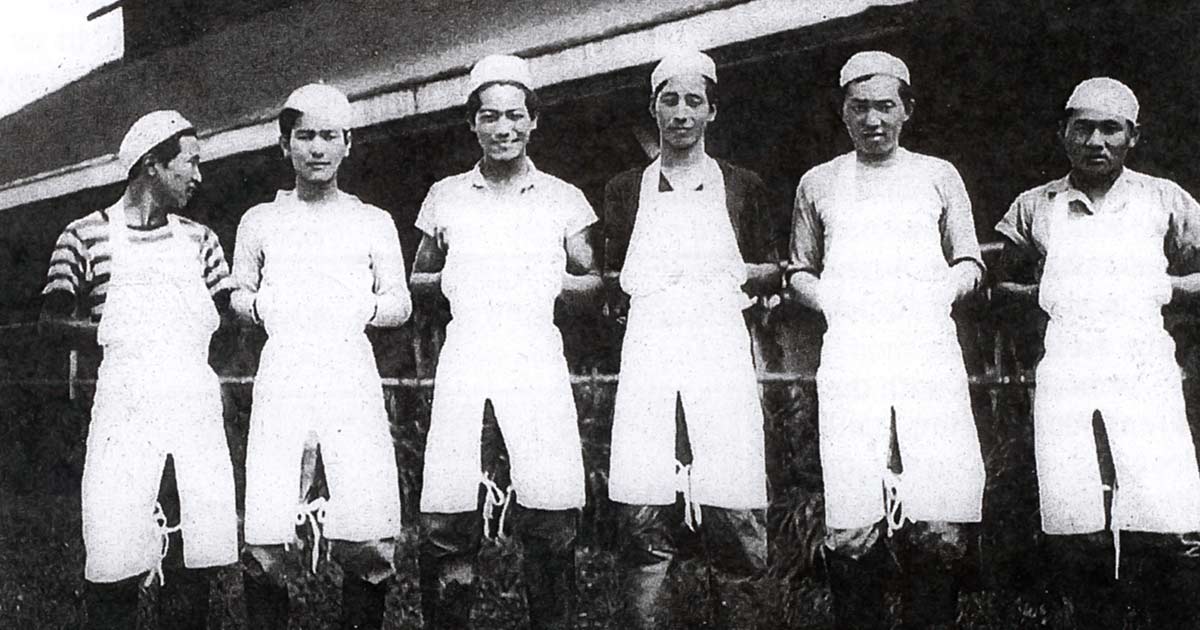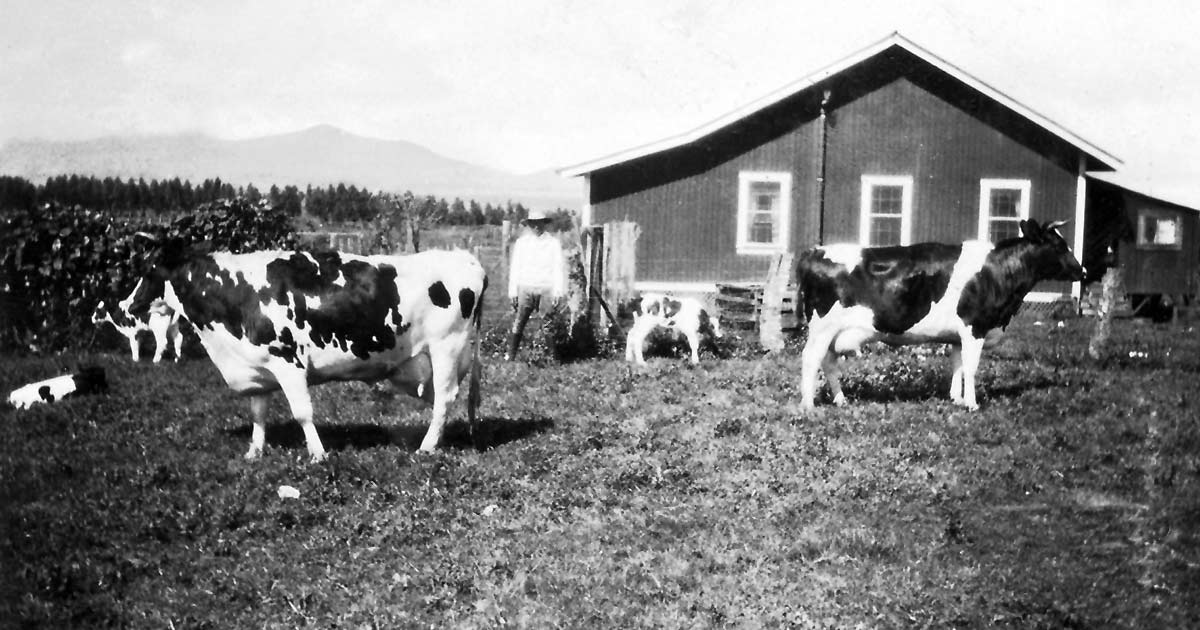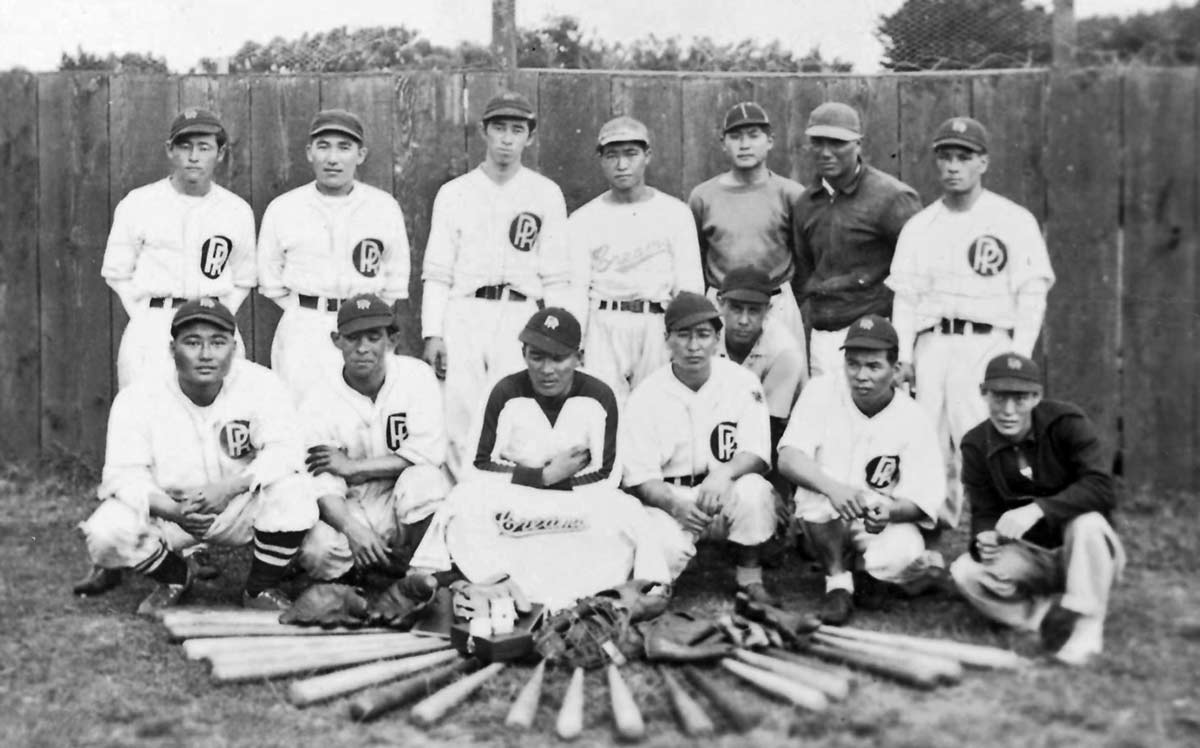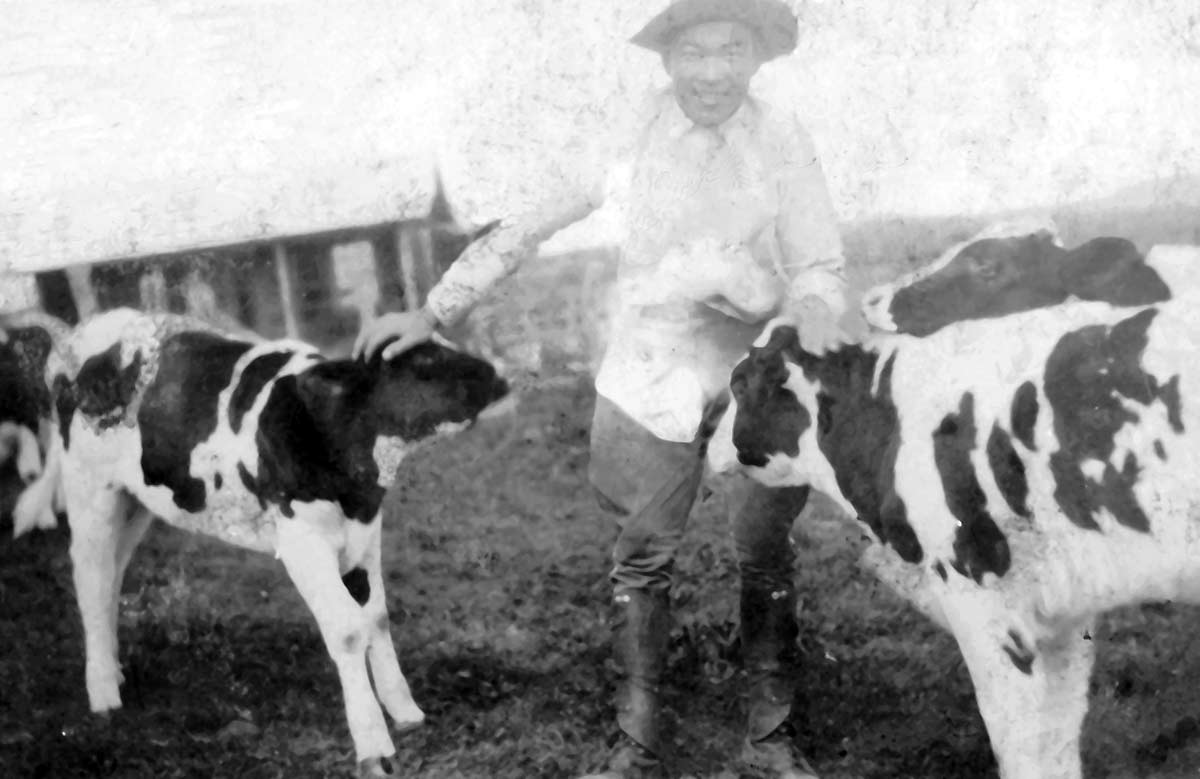
Dairy boys, working under highly sanitary conditions, proudly show their working apparel, with hands folded neatly behind the aprons. Left to right: Shigeo Yagi, Yoshiharu Goya, Shigeo Kuba, Niroku Dochin, Morito Ota, and Ichiro Yamaguchi. (A.W. Carter Collection)
In 1847, when Ranch founder and patriarch John Palmer Parker acquired the property at Mana, milk cows were part of the family herd. He and his sons built a small household dairy near the home, along with a saddle house and blacksmith shop, wagon and plow shed, meat house, and a cooking hale with imu and smokehouse.*

In 1853, Ranch manager A.W. Carter expanded what became known as the “Old Dairy” to a place called Paliho‘oūkapapa, two miles east of Mana, and twelve miles from Waimea town. It was a simple milking barn, with māmane posts, koa walls, and a few windows for light, but its 150 cows produced enough milk for ranch employees and the growing Waimea community.
Cheese and butter were delivered by horse-drawn wagon to be sold for about 50 cents per pound. (Because nothing went to waste, surplus milk was fed to the pigs whose pork would be smoked, cured, and made into sausage, pickled pigs feet, or head cheese). Challenged by the increasing demand for dairy products, Carter upgraded the dairy herd to about 750 head, with better-grade milking shorthorn bulls from the mainland and Holstein bulls from New Zealand.
The “New Dairy” facility was built between 1920-24 at Pu‘ukīkoni, for a total cost of $35,000, under direction of Martin Campbell. At its peak they milked 200 cows twice daily. A separate creamery contained a pasteurizer (with wood-burning steam boiler), a cold storage plant, bottling plant, and equipment for butter, cottage cheese, and cheddar cheese production.
Carter wrote to Dr. W.L. Williams of Cornell University, looking for a “good Dairyman who will be able to handle the cows and make butter. In selecting a man to bring the bulls and heifers out here, you might keep that in mind. I intend installing an up to date creamery and should like to get a man for the same. He should be a good herdsman as well as butter and cheese maker. I would pay $150.00 per month and in addition would supply cottage and free firewood.”*
Williams agreed to take on the project on a consulting basis. He also took on a protégé, a young Yutaka Kimura, who would become Dairy Foreman at age 19. Up to 24 “Dairy Boys” worked and lived at the dairy, one of whom was legendary paniolo Jiro Yamaguchi. The Dairy Boys proudly sported their own football team, a horse racing crew, and the “Parker Ranch Creams” baseball team.

In the late 1930s, Kimura offered a dairy job to his brother, Hisao. From Hisao’s oral history** interview with Holly Yamada:
“My dairy job was quite interesting because as I said, A.W. Carter was such a perfectionist, more or less, you know. Everything gotta be number one. Everything gotta be just the way he wants it. And when he started that dairy, he imported all his dairy herd. They’re all registered, registered with pedigree. And their pedigree go back about three generation… And my brother hate to be taking care of the books, so he gave me the job of staying in the office and keep record of all the registered herd.”
Hisao had to milk cows and do the regular Dairy Boy chores, and also keep records of every cow’s milk production by gallons. He also had to document every new cow.

“Every calf that’s born, immediately we have to put a record on the calf, the date of birth. And then after about three to four weeks, I go out, in the pasture and draw (the) picture of that calf, the markings rather. But it’s so easy because the outline of the calf is there. It’s a blank outline and on top of that you put the black spot and markings, yeah, yeah. And then with that drawing, you send that as part of the registration of the calf.”
By 1944, the dairy was shipping 1,400 quarts of milk to Hilo four times weekly, in addition to providing for Parker Ranch employees and Waimea folks. “The basis of the Parker Ranch Standard indeed can be ascribed to the dairy. The dairy was a vital component of the community, especially during the World War II years,” according to Dr. Bergin.*
Parker Ranch played a big part in WWII, leasing (for $1) acreage to the military for training facilities at Camp Tarawa, and helping provide food and supplies for the 50,000 marines stationed there. During those years, troops built Canec structures behind St. James Church, one of which was an ice house. Thanks to them, Waimea had its first ice cream (from Parker Ranch milk), from then on the favorite treat at the annual Parker Ranch Christmas Parties.
The dairy moved to Waimea town in 1949, to a 20-acre spread on Mana Road, where Veterinary Associates Case Memorial Veterinary Hospital now resides. The adjacent original dairy building was restored to its historic design by the Veterinary Associates and then became home of the animal health supply outfit, RR Olson, Inc.
The new dairy facility featured a brand new automated milking system.
“The morning at Pu‘ukīkoni started at 3 a.m. with the last hand-milking in ranch history. As twenty-four select top producers were finished, trucks stood by for delivery of the cows to the Pu‘ukapu facility, where very gentle indoctrination and training of the animals and staff were practiced. The cows were placed in their new stanchions to receive the cylindrical suction cups… By mid-afternoon the cows were acclimated to the new barn and automatic milking parlor, which was ready for the evening shift to begin.”
The Parker Ranch Dairy continued to operate until 1962, when Normal Greenwell made an attractive offer for the business. Parker Ranch no longer viewed the dairy as a community need to be borne by the ranch, and decided to concentrate on beef cattle.
At one time, Hawai’i hosted 160+ dairies, producing 33 million gallons of milk every year. Today, the Big Island’s Cloverleaf dairy in North Kohala, is the last remaining dairy on the island and the only privately-owned one in the state.
*Most of the information for this article was obtained from Bergin, Dr. Billy. Loyal to the Land: The Legendary Parker Ranch, 750-1950 (pp. 508-509). University of Hawaii Press, available at the Paniolo Heritage Center Gift Shop.
**https://www.nps.gov/valr/learn/historyculture/upload/HisaoKimura1.pdf
